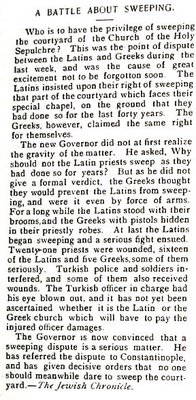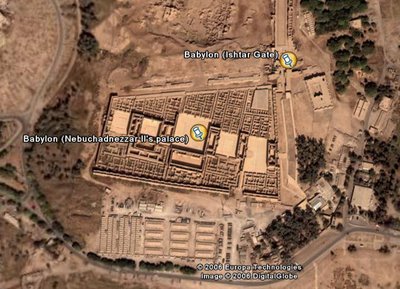You hear about the fights in the Church of the Holy Sepulcher, but I’ve never read as good of an account as this one.
The source is William E. Blackstone, The Jewish Era. Thanks to Jonathan Moorhead for sending it my way.
Some fanatic BiblePlaces readers have suggested that I go to Iraq and take pictures of the biblical sites there. Here are four reasons why that is a bad idea.
But it may be, and thus this inquiry, that there are people who have such pictures and would be interested in making them available to Bible teachers and students. These people could include soldiers recently in Iraq or tourists who went in safer days. So I’m putting a call out for anyone who has 1) good quality photos that 2) they can clearly identify of 3) biblical, Assyrian, and Babylonian sites in Iraq and is 4) willing to share them with a large audience. If that’s you, drop me a note. Or you know someone in this category, have them email me.
For those of you who want such photos, you are free to comment here, but there’s no need to pursue me. I’ll let you know if and when such is available via the BiblePlaces Newsletter (signup here).
 This is a screenshot from the amazing Google Earth of Nebuchadnezzar’s palace in Babylon.
This is a screenshot from the amazing Google Earth of Nebuchadnezzar’s palace in Babylon.
I’ve been asked what the top 5 archaeological discoveries related to the biblical record have been discovered in the last 5 years. I’m not really sure where to start in formulating a list except from my memory. So I’ll start a list here and welcome suggestions for additional items.
James Ossuary (forgery?)
Jehoash Inscription (forgery?)
“Goliath” inscription from Gath
Ketef Hinnom Silver Amulets – new inscription
Palace of David (?)
9th century seals from City of David (not announced as far as I know)
Noah’s Ark (3 or 4 times!)
A few notes:
1. This list is in no particular order.
2. The experts that I trust have not been convinced that the James Ossuary and Jehoash Inscription are forgeries. Some experts that I decidedly do not trust are convinced that they are forgeries. I have
included them on this list until there is greater agreement on the matter.
3. I am not claiming that these items mean everything that has been attributed to them by various writers. I am also reserving judgment about the identification of the “palace of David,” but include it here because it seems, in any case, to be a significant building in OT Jerusalem.
4. The Noah’s Ark thing is a joke. (Here’s an easy way to know if something is a genuine hoax: if it has the names of Ron Wyatt or Robert Cornuke attached to it.)
- Tagged Analysis
We’ve reported in multiple BiblePlaces Newsletters and here about the plan to excavate the collapsed earthen ramp leading from the Western Wall plaza to the Temple Mount. This ramp gives access to the only Temple Mount gate open to non-Muslims. Haaretz reports today that the Israel Antiquities Authority will begin digging in a few days.
The ramp, which leads from the Western Wall plaza to one of the Temple Mount Gates, is located in one of the most sensitive places in the world, and plans to carry out excavations under it have therefore been held up by the Shin Bet security service and the prime minister’s military secretary for the past two years, for fear of Muslim riots.
Archaeologist Meir Ben-Dov warned yesterday that any digging in the area could lead to bloodshed.
“Digging in this place goes way beyond the archaeological sphere. This place is far too sensitive and the price would be much too high,” he said.
However, a reliable source told Haaretz that “now that the Palestinian Authority is paralyzed and incapable of resisting, it’s an excellent opportunity to carry out the plan.”
These photos were taken in the last year.The temporary wooden ramp is on the left side of the earthen ramp to be excavated.
The north side of the earthen ramp collapsed after a snowfall in February 2004.
The ramp is more prominent when viewed from the south side. The new excavations will apparently create a connection between the Western Wall prayer plaza and the Jerusalem Archaeological Park (aka Southern Temple Mount Excavations).
- Tagged Jerusalem, Temple Mount
I went to Gezer today. I was at Gezer last month and it looked pretty much the same as it has for the last 15 years. Overgrown. Devoid of tourists. Overgrown. Lacking signs or a good access road. But today was different.
The first surprise was the signs. There was a sign at every archaeological area plus one.
The signs, for the most part, were very good. They’re all in three languages, attractive, and generally accurate. The text wasn’t written by a clerk in an office but by an archaeologist.
This sign, however, I cannot figure out. (The apparent error is repeated in the Hebrew text, so it’s not just an inadvertent typo.)
The next surprise was the state of the major archaeological discoveries. All were cleared of their overgrowth. What a difference that makes! Take a look at the Solomonic gate.
Of course, that should be “Solomon’s Gate” according to the official sign. The quotes are important.
And in spite of what the excavating archaeologists have said, the gate is only “probably” dated to the 10th century. Is such a nod to Finkelstein and his sliver of scholarship really necessary here?
The reason for the beautiful state of things is two-fold. First, the Israel Parks Authority decided to take action and make some improvements, including clearing trails and erecting signs. Second, new excavations are underway at Gezer for the first time in 20 years. Led by Dr. Steven Ortiz and Sam Wolff, the team of 60 has made huge progress in the last month in excavating the casemate wall west of the Solomonic Gate (no quotes). That in addition to their work in clearing the weeds away from the sites.
There’s a consortium of about six schools that have students and faculty participating. My bet: next year there are more.
And why not? It’s a perfect site to dig: tons of textual history associated with it, prominent in the Bible, close to Jerusalem, excellent housing facilities, first-rate excavators, and staffed by wonderful people.
Back to the site itself. The watersystem (Middle Bronze?) will soon be open to the public, with a staircase now being installed.
What’s lacking? A decent road to get there. You can drive a car, but to get a bus driver to agree is not easy. And if it has rained in the last 10 days, forget it. And the Late Bronze tombs are still overgrown, filled with junk, and hard to find.
But with all of this, who can complain?
Want more? Take a look at the Gezer Excavations Project website, one supervisor’s blog of the excavations or the BiblePlaces Gezer page, which has even more links to Gezer-related sites.
A friend wrote and asked what my top 3, 5 or 10 discoveries in the British Museum would be. The first thing is to realize that any reduction to such a number is going to eliminate a lot of major finds.
But there’s also the realization that a person has only so much time and so many brain cells. So here’s my top 15. I can’t reduce it any further than this. The list is in roughly chronological order. Some are more closely related to the Bible than others.
1. Epic of Gilgamesh
2. Amarna Letters
3. Kurkh Stela of Shalmaneser III
4. Black Obelisk
5. Samaria Ivories
6. Taylor Prism (Sennacherib)
7. Lachish Siege Reliefs
8. Shebna Inscription
9. Babylonian Chronicle for 605-594
10. Lachish Letters
11. Cyrus Cylinder
12. Temple of Artemis column
13. Elgin Marbles
14. Rosetta Stone
15. Politarch Inscription
If you want to suggest an addition, please also suggest one of the above to remove.
In any case, if you’re planning a visit, the book that you must get is by Peter Masters, entitled Heritage of Evidence in the British Museum. It used to be hard to find, though I now see it listed for sale at Amazon and here and here.
Does anyone offer a B.A. in the British Museum? That’s not overreaching, in my opinion. Especially given what other college programs exist these days.
- Tagged Analysis
Search
About the BiblePlaces Blog
The BiblePlaces Blog provides updates and analysis of the latest in biblical archaeology, history, and geography. Unless otherwise noted, the posts are written by Todd Bolen, PhD, Professor of Biblical Studies at The Master’s University.
Subscribe
Tags
10th Century
American Colony Photos
Analysis
Antiquities Trade
Dead Sea
Dead Sea Scrolls
Discoveries
Egypt
Excavations
Forgery
Galilee
Greece
Holidays
Israel's Coast
Italy
Jerusalem
Jezreel Valley
Jordan
Jordan Rift
Judah
Lebanon
Lectures
Mediterranean Islands
Mesopotamia
Museums
Negev
New Exhibits
Persia
Philistines
Photo Resources
Picture of the Week
Pseudo-Archaeology
Resources
Sad News
Samaria
Shephelah
Syria
Technology
Temple Mount
Tomb of Jesus
Tourism
Travels
Turkey
Weather
Weekend Roundup
Links
Notice
As an Amazon Associate we earn from qualifying purchases. In any case, we will provide honest advice.